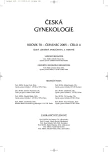What Ultrasound Parameter is Optimal in the Examination of Position and Mobility of Urethrovesical Junction?
Který z ultrazvukových parametrů je optimální při vyšetření uložení a mobility uretrovezikální junkce?
Cíl studie:
Cílem studie je zhodnotit validitu ultrazvukového měření, zjistit chybu měření jednotlivce a rozdíl mezi různými lékaři a určit nejpřesnější parametr pro vyšetření uložení a mobility UVJ.
Typ studie:
Pilotní studie.
Název a sídlo pracoviště:
Gynekologicko-porodnická klinika VFN a 1. LF UK, Praha. Euromise, Karlova univerzita a Akademie věd ČR, Praha.
Metodika:
Do studie bylo zařazeno 50 žen. V systému souřadnic byla osa x definována jako osa symfýzy, s 0 v dolním okraji symfýzy, osa y je kolmá na osu x. V tomto systému byl měřen rotační úhel gama a vzdálenost p. Měření byla provedena v klidu a při maximálním Valsalvově manévru a opakovány každým vyšetřujícím 2krát. Přesnost UZ vyšetření byla statisticky vyhodnocena.
Výsledky:
Chyby při stanovení vektoru pohybu (vzdálenost mezi bodem v klidu a při maximálním Valsalvově manévru) měly typickou chybu 2,2 a 2,4 mm pro prvního a druhého vyšetřujícího. Pro 1. vyšetřujícího byl posun mezi prvním a druhým měřením 2,1 mm (SD=1,5 mm), pro druhého vyšetřujícího 3,3 mm (SD=1,7), rozdíly mezi vyšetřujícími jsou statisticky významné. Rozdíly v měření při Valsalvově manévru byly identické. I když variabilita měření pro oba lékaře je velmi podobná, neznamená to, že výsledná měření jsou identická. Vektor pohybu však není ovlivněn variabilitou měřených parametrů.
Závěr:
Rozdíly mezi vyšetřujícími jsou nejspíše způsobeny odlišným zvolením osy symfýzy – minimální rozdíly ve vektoru. Rozdíly v měření mezi vyšetřujícími jsou statisticky významné.
Klíčová slova:
transperineální ultrazvuk, inkontinence moči, stresová inkontinence moči, uretrovezikální junkce
Authors:
J. Mašata 1; K. Švabík 1; A. Martan 1
; P. Drahorádová 1; M. Pavlikova 2
Authors‘ workplace:
Gynekologicko-porodnická klinika VFN a 1. LF UK, Praha, přednosta prof. MUDr. A. Martan, DrSc.
1; Euromise centrum, Karlova univerzita a Akademie věd ČR, Praha, ředitelka prof. RNDr. J. Zvárová, DrSc.
2
Published in:
Ceska Gynekol 2005; 70(4): 280-285
Category:
Original Article
Overview
Objective:
The aim of our study was to asses the validity of the ultrasound measurements, effect of the operator on the measurement and to find most accurate parameters for the monitoring of the bladder neck.
Design:
Pilot study.
Setting:
Obstet. Gynecol Department, General teaching hospital, Ist Medical Faculty, Charles University, Prague. EuroMISE centre of the Charles University and Academy of Sciences, Prague, Czech Republic.
Methods:
50 women were included in the study. The coordinate system was defined as follows: the x axis is the axis of the symphysis, with 0 at lower edge of the symphysis. The y axis is perpendicular to x. In this system the rotational angle gama (γ) and distance (p) were measured. The measurements were taken at rest and during maximal Valsalva, repeated independently twice by each observer.
Reliability of measurements was statistically tested.
Results:
The vector of movement (distance between the position of the point at rest and at maximal Valsalva) shows a typical error of 2.2 and 2.4 mm for Operator 1 and 2, respectively. For Operator 1 the shift between two measurements was 2.1 (SD 1.5 mm); for Operator 2 the value was 3.3 (SD=1.7mm), (differences between the operators are statistically significant). Differences at maximal Valsalva were similar.
While the variability in measuremets is similar for both operators, this does not mean that final measurements are the same. The vector of the movement is not influenced by the variability of the measured parameters.
Conclusions:
Differences between the operators are probably due to different placement of the axis of the symphysis, as there are minimal differences in vector of movement. Statistical evaluation indicates that the differences between the operators are statistically significant.
Key words:
transperineal ultrasound, stress urinary incontinence, bladder neck
Labels
Paediatric gynaecology Gynaecology and obstetrics Reproduction medicineArticle was published in
Czech Gynaecology

2005 Issue 4
Most read in this issue
- Prenatal Parvovirus B19 Infection in Fetus
- The Detection of p16 Protein in Uterine Cervix Lesions
- Changes in Vesicalization of Urethra and Bladder after TVT Operation
- Antibiotics prophylaxis in laparoscopy
